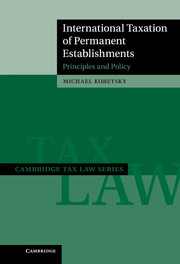Book contents
- Frontmatter
- Contents
- Abbreviations
- 1 Introduction
- 2 International taxation: policy and law
- 3 Some shortcomings of the tax treaty system
- 4 History of tax treaties and the permanent establishment concept
- 5 The role of the OECD Model Tax Treaty and Commentary
- 6 Defining the personality of permanent establishments under former Article 7 and the pre-2008 Commentary and the 2008 Commentary
- 7 Intra-bank loans under the pre-2008 Commentary and 1984 Report
- 8 Intra-bank interest under the 2008 Report
- 9 Business restructuring involving permanent establishments and the OECD transfer pricing methods
- 10 New Article 7 of the OECD Model and Commentary
- 11 Unitary taxation
- 12 Conclusion
- Bibliography
- Index
6 - Defining the personality of permanent establishments under former Article 7 and the pre-2008 Commentary and the 2008 Commentary
Published online by Cambridge University Press: 07 September 2011
- Frontmatter
- Contents
- Abbreviations
- 1 Introduction
- 2 International taxation: policy and law
- 3 Some shortcomings of the tax treaty system
- 4 History of tax treaties and the permanent establishment concept
- 5 The role of the OECD Model Tax Treaty and Commentary
- 6 Defining the personality of permanent establishments under former Article 7 and the pre-2008 Commentary and the 2008 Commentary
- 7 Intra-bank loans under the pre-2008 Commentary and 1984 Report
- 8 Intra-bank interest under the 2008 Report
- 9 Business restructuring involving permanent establishments and the OECD transfer pricing methods
- 10 New Article 7 of the OECD Model and Commentary
- 11 Unitary taxation
- 12 Conclusion
- Bibliography
- Index
Summary
Introduction
Former Article 7 establishes a long-standing treaty principle for allocating the business profits of an international enterprise operating through permanent establishments. The rationale underlying former Article 7 is that when an enterprise operates in a host country through a permanent establishment, the enterprise is participating in the economic life of that country. Consequently, former Article 7 allocates to a host country taxing rights over business profits attributable to a permanent establishment in the host country. Former Article 7 is based on the arm's length principle and purports to treat a permanent establishment as a separate entity for the purpose of allocating profits and expenses to it.
Prior to the publication of the 2008 Commentary on former Article 7 there was no OECD consensus interpretation of the provision, despite the revision of the Commentary in 1994. This led to the OECD issuing a series of discussion drafts on former Article 7 resulting in the publication in July 2008 of the ‘authorized OECD approach’ on interpreting former Article 7 – the consensus interpretation – in the 2008 Report. In order to quickly adopt the 2008 Report, the OECD used a two-step implementation procedure, which has created uncertainty. In the first step, in 2008 the OECD amended the Commentary on former Article 7 (2008 Commentary) which implemented the parts of the ‘authorized OECD approach’ in the 2008 Report that do not conflict with the pre-existing version of the Commentary (pre-2008 Commentary). This approach implies that the 2008 Commentary may be used to interpret the business profits Article of tax treaties concluded before July 2008. It is bold for the OECD to claim that the ‘authorized OECD approach’, which is a new interpretation, can be immediately applied to tax treaties finalized before July 2008 on the unconvincing claim that the authorized OECD approach in the 2008 Commentary does not conflict with the pre-2008 Commentary. The authorized OECD approach is a new interpretation of former Article 7 which was established after several years of discussions by OECD countries.
- Type
- Chapter
- Information
- International Taxation of Permanent EstablishmentsPrinciples and Policy, pp. 179 - 237Publisher: Cambridge University PressPrint publication year: 2011



